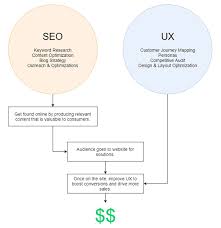
In the digital landscape, the realms of User Experience (UX) and Search Engine Optimization (SEO) have long been considered as separate entities with distinct goals. However, in recent years, a paradigm shift has occurred, highlighting the importance of integrating UX and SEO strategies to achieve optimal results.
UX focuses on enhancing user satisfaction by improving the usability, accessibility, and overall interaction with a website or application. On the other hand, SEO aims to increase a website’s visibility on search engine results pages through strategic optimization techniques.
When UX and SEO work in harmony, they create a powerful synergy that not only enhances user experience but also boosts search visibility. By aligning design elements, content structure, and navigation with SEO best practices, websites can attract more organic traffic while providing users with a seamless browsing experience.
To leverage the benefits of UX-SEO integration, businesses should consider:
The synergy between UX and SEO is undeniable in today’s digital landscape. By prioritising user experience alongside search engine optimisation efforts, businesses can create websites that not only attract visitors but also convert them into loyal customers. Embracing this holistic approach is key to staying competitive in an ever-evolving online environment.
Ensuring that your website is mobile-friendly is crucial for enhancing both user experience and SEO ranking. With the increasing number of users accessing websites on mobile devices, a responsive design that adapts to different screen sizes and resolutions is essential. A mobile-friendly website not only provides a seamless browsing experience for visitors but also signals to search engines like Google that your site is user-friendly, potentially improving its ranking in search results. By prioritising mobile responsiveness, you can cater to a wider audience and boost both user satisfaction and search visibility.
Optimising page load speed is a crucial aspect of UX SEO strategy as it significantly impacts user satisfaction and bounce rates. A fast-loading website not only provides a seamless browsing experience for visitors but also encourages them to explore further, ultimately reducing the likelihood of users leaving the site prematurely. By prioritising page load speed, businesses can create a more engaging and user-friendly environment that keeps visitors engaged and improves overall website performance.
Utilising clear and descriptive headings and subheadings is a fundamental tip in UX SEO strategy. By structuring content with easily identifiable headers, users can navigate a website effortlessly, enhancing their overall experience. Additionally, search engines rely on these headings to understand the context and relevance of the content, thereby improving the site’s SEO performance. Clear headings not only guide users through the information but also signal to search engines the key topics covered on a page, ultimately contributing to better visibility in search results.
When focusing on UX SEO, it is crucial to implement an intuitive site architecture with a logical hierarchy to enhance user flow. By organising content in a clear and structured manner, users can easily navigate through the website, find information efficiently, and engage with the content seamlessly. This approach not only improves the overall user experience but also signals to search engines the relevance and importance of different pages, ultimately boosting search visibility and ranking.
Optimising images with descriptive alt text is a crucial aspect of UX SEO. By providing alt text that accurately describes the content of an image, websites can enhance accessibility for visually impaired users who rely on screen readers. Additionally, search engines use alt text to understand the context of images, which can improve indexing and ultimately boost the website’s visibility in search results. This simple yet effective practice not only enhances user experience but also contributes to better SEO performance, highlighting the interconnected nature of UX and SEO strategies.
Creating high-quality, engaging content that directly addresses users’ needs and queries is a fundamental tip in the realm of UX SEO. By crafting content that resonates with the target audience, businesses can not only improve user experience but also enhance search engine visibility. When users find relevant and valuable information on a website, they are more likely to engage with the content, stay longer on the site, and ultimately convert into loyal customers. This approach not only satisfies users but also signals search engines that the website provides authoritative and useful content, thereby boosting its ranking in search results.
Incorporating internal linking into your website is a powerful UX SEO strategy that can guide users through related content seamlessly. By strategically linking relevant pages within your site, you not only enhance navigation and user experience but also improve search engine visibility. Internal linking helps users discover more valuable information on your website, encourages them to explore further, and increases the time they spend engaging with your content. This practice not only benefits users by providing a cohesive browsing experience but also signals to search engines the importance and relevance of specific pages, ultimately boosting your site’s overall SEO performance.
Utilising responsive design is a crucial tip in the realm of UX SEO, as it ensures a seamless and consistent user experience across all devices. By implementing a responsive design approach, websites can adapt to various screen sizes and resolutions, providing users with optimal viewing and interaction regardless of whether they are accessing the site on a desktop, tablet, or mobile device. This not only enhances user satisfaction but also contributes to improved search engine rankings, as search engines like Google favour mobile-friendly websites. In essence, responsive design plays a pivotal role in creating a user-centric website that is both visually appealing and functional across the digital landscape.